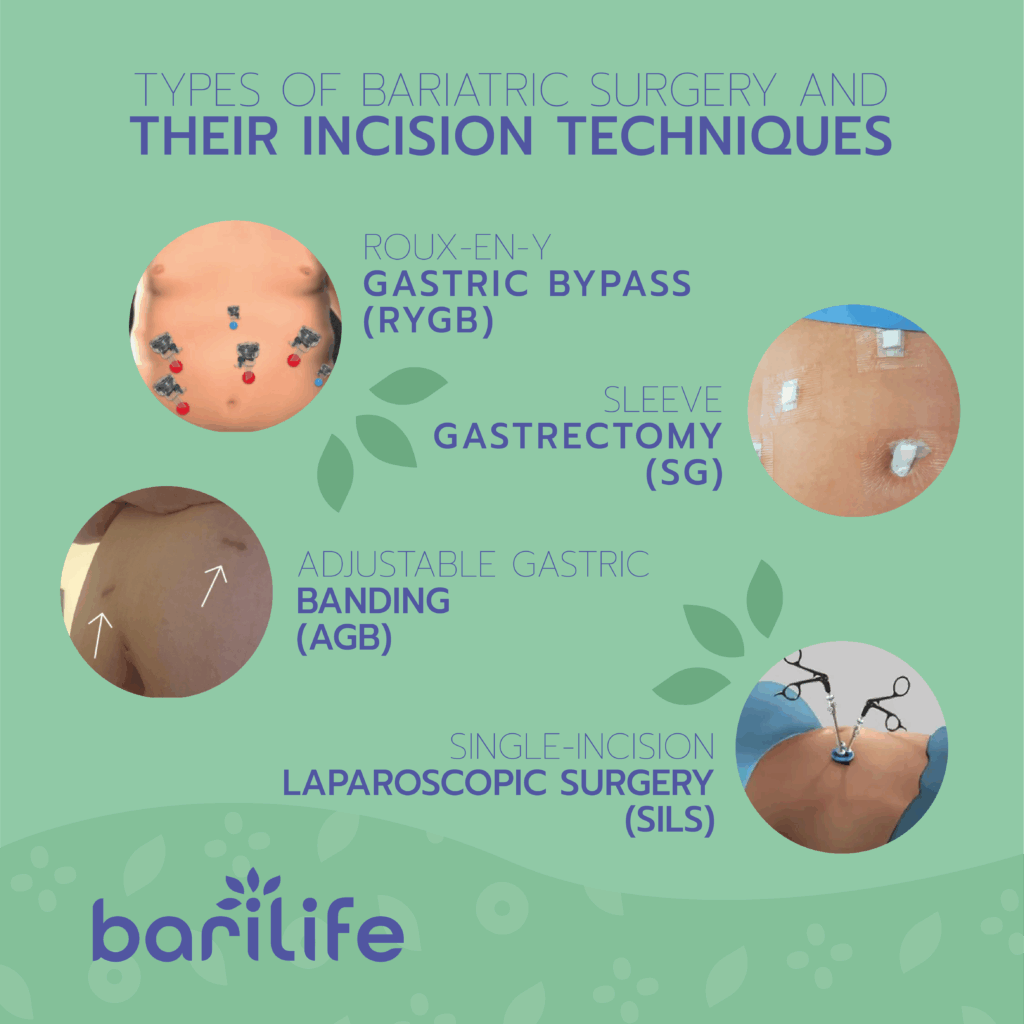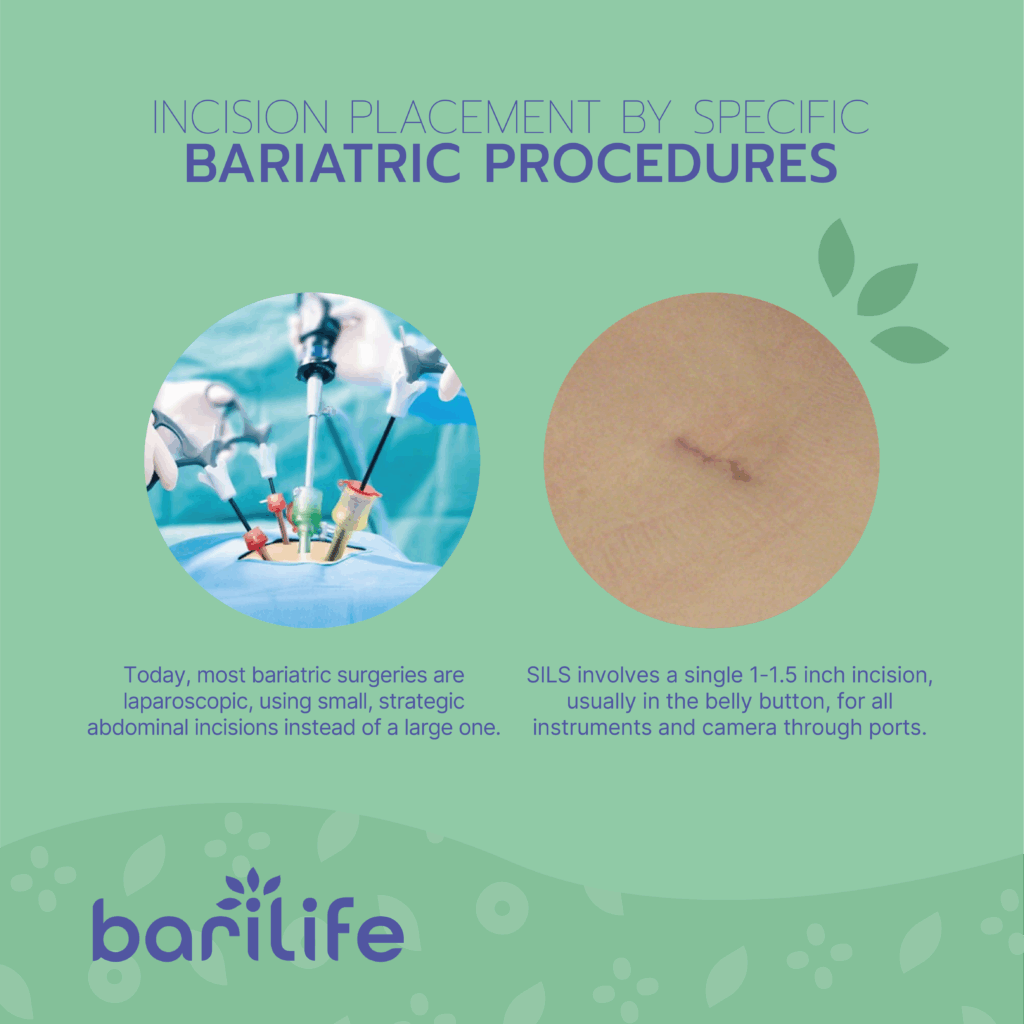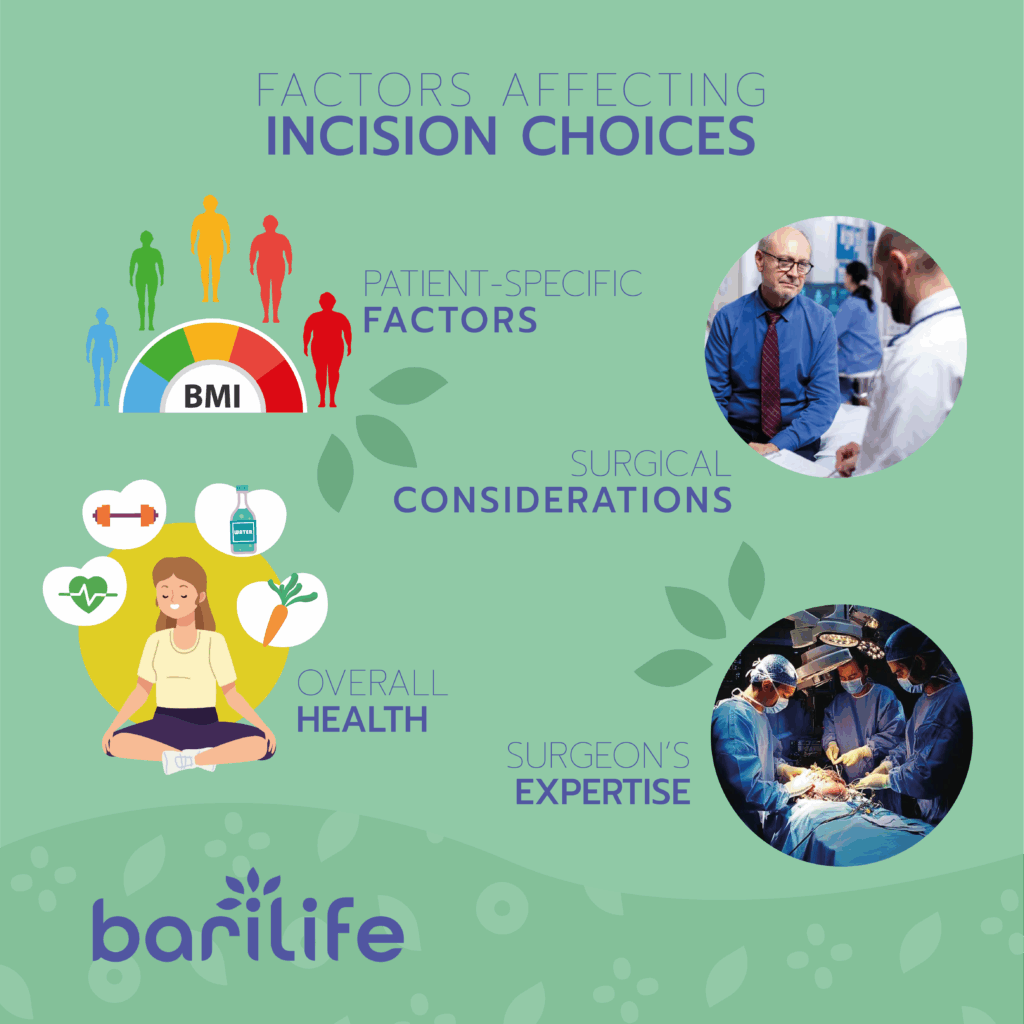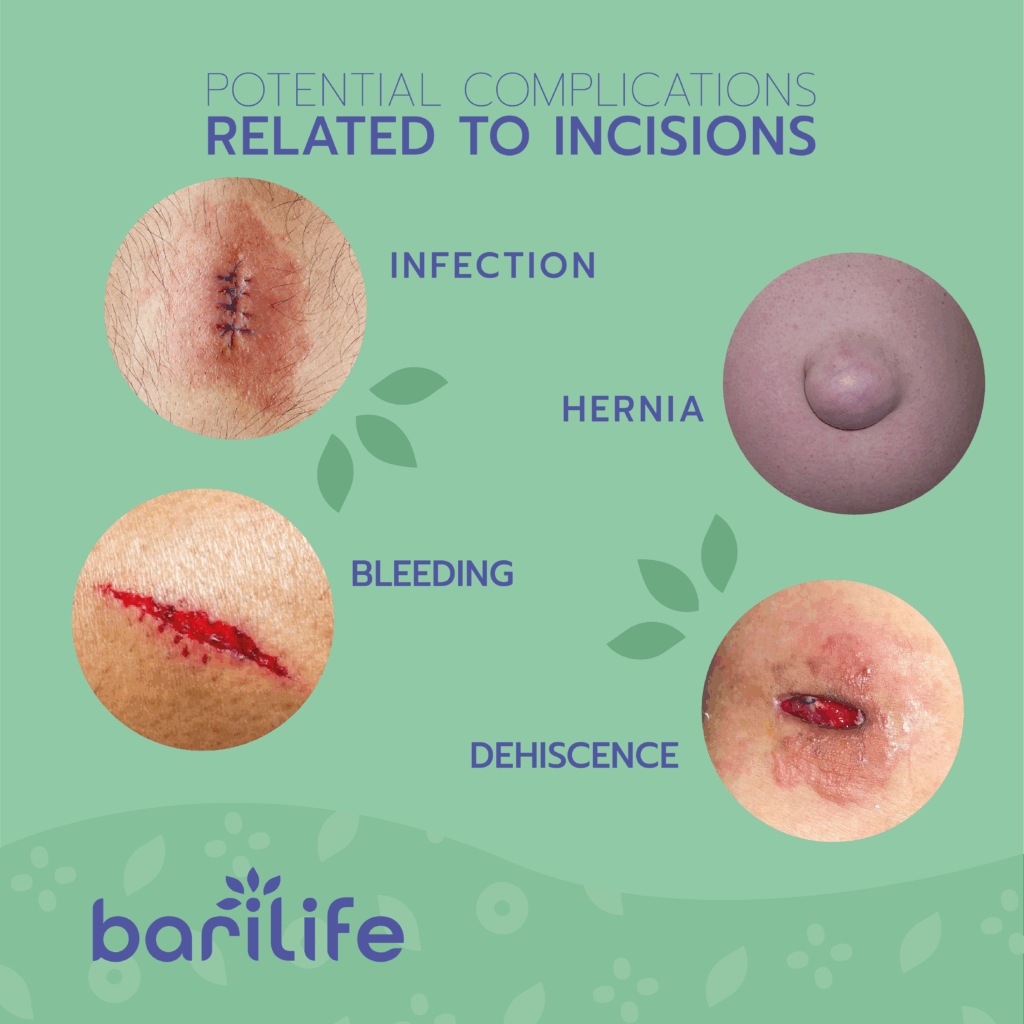Key Takeaways:
- Most bariatric procedures are done using minimally invasive techniques with small incisions.
- Incision care is important for healthy healing and avoiding complications.
- Knowing when to seek medical help for incision problems can prevent serious complications.
So you’re about to get weight loss surgery, or you’ve recently undergone a procedure, and you now have questions about bariatric surgery incisions. Knowing what to anticipate can help ease your worries and ensure that you heal properly.
Let’s explore everything you need to know about the cuts made during surgery, how they heal, and when you should be concerned.
Table of Contents
Types of Bariatric Surgery and Their Incision Techniques

The kind of weight loss procedure you get determines the number, size, and location of your incisions. Here are the most common procedures and their incision approaches:
Roux-en-Y Gastric Bypass (RYGB)
This popular procedure creates a small stomach pouch and reroutes part of your small intestine. When performed laparoscopically, it typically involves 5-6 small incisions across your abdomen. Each incision is usually about 1/4 to 1 inch long.
In some cases, gastric bypass might be performed as an open surgery, which requires a single, larger incision (6-8 inches) down the middle of your abdomen. However, this approach is becoming increasingly rare and is typically only used in complex cases or when laparoscopic surgery isn’t possible.
Sleeve Gastrectomy (SG)
This procedure removes about 80% of your stomach, creating a banana-shaped “sleeve.” Like gastric bypass, sleeve gastrectomy is usually performed laparoscopically with 4-5 small incisions across your abdomen.
Adjustable Gastric Banding (AGB)
This less common procedure places an adjustable band around the upper part of your stomach. It’s almost always performed laparoscopically, typically using 3-5 small incisions. One incision will be slightly larger to allow the placement of the band’s port, which sits under your skin and allows the band to be adjusted after surgery.
Single-Incision Laparoscopic Surgery (SILS)
This advanced technique uses just one entry point, often hidden in your belly button. SILS can be used for procedures like adjustable gastric banding and, in some cases, sleeve gastrectomy. The main advantage is cosmetic—with just one incision hidden in your navel, there’s virtually no visible scarring afterward.
Incision Placement by Specific Bariatric Procedures
Wondering where your incision may be? Here’s a breakdown by procedure.
Laparoscopic Procedures
Most bariatric surgeries today use laparoscopic techniques involving several small incisions rather than one large cut. These incisions are strategically placed around your abdomen and typically include:

- One incision near your belly button (this is often the largest, about 1/2 to 1 inch)
- Several smaller incisions (usually 1/4 to 1/2 inch) in the upper abdomen
- Sometimes, an incision on the left side of your abdomen
Through these small openings, your surgeon inserts a tiny camera and special instruments to do the surgery. The camera reflects images to a monitor so your surgeon can see inside your body without making a large incision.
Single-Incision Laparoscopic Surgery (SILS)
With SILS, your surgeon makes just one incision, typically in your belly button. This single opening (usually about 1 to 1.5 inches) allows all the necessary instruments and camera to be inserted through specially designed ports. The belly button naturally conceals the resulting scar, often making it nearly invisible once healed.
While cosmetically appealing, SILS is technically more challenging and may not be suitable for everyone. Your surgeon will determine whether this approach is appropriate based on your specific situation.
Factors Affecting Incision Choices
Several factors influence the type and placement of incisions during your bariatric surgery:
Patient-Specific Factors
- Body mass index (BMI) and fat distribution: Higher BMIs or certain patterns of fat distribution might require specific incision placements for optimal access.
- Previous surgeries: If you’ve had abdominal surgery before, existing scar tissue might affect where new incisions are placed.
- Overall health: Your overall health and existing medical conditions might influence the surgical approach.
Surgical Considerations
- Type of procedure: Different bariatric surgeries require different access points. For example, placing an adjustable gastric band requires fewer incisions than a gastric bypass.
- Surgeon’s expertise: Your surgeon’s training, experience, and comfort with specific techniques play a significant role in incision choices.
- Available equipment: Some advanced techniques like SILS require specialized equipment that may not be available at all facilities.

Healing and Post-Operative Care for Incisions
Proper care of your bariatric surgery incisions is essential for sound healing and preventing complications:
Laparoscopic Incisions
One of the major benefits of laparoscopic bariatric incisions is their faster healing time. These small cuts typically heal within 1-2 weeks, with less pain and scars compared to open surgery. Most people can return to light activities within days and more normal activities within 2-3 weeks.
Your incisions will be closed using dissolvable stitches, surgical glue, steri-strips (small adhesive strips), or staples, which your healthcare provider will remove at a follow-up appointment.
SILS Incisions
Single-incision laparoscopic surgery may result in even less post-operative pain than traditional laparoscopic approaches. Since there’s only one incision, only one area needs to heal. However, because this incision is slightly larger than individual laparoscopic incisions, it may take a similar amount of time to heal completely.
General Incision Care Guidelines
Here are some guidelines for how to care for your incisions.
- Keep incisions clean and dry for at least 48 hours after surgery
- Follow your surgeon’s specific instructions about showering
- Stay away from baths, hot tubs, and swimming pools until your surgeon gives permission
- Do not apply lotions, creams, or ointments to incisions unless directed by your surgeon
- Wear loose-fitting clothing that doesn’t rub against your incisions
- Support your abdomen with a pillow when coughing or sneezing
Potential Complications Related to Incisions
While most bariatric surgery incisions heal without problems, complications can occur:
- Infection: Signs of infection include increasing warmth, redness, swelling, or discharge from the incision site. You might also have a fever or feel generally unwell.
- Hernia: A hernia occurs when internal tissue bulges through a weakened area in the muscle wall. They appear as a bulge under the skin that might be more noticeable when standing or straining.

- Bleeding: Some bleeding or oozing from incisions is normal in the first 24-48 hours. However, heavy bleeding or bleeding that doesn’t stop should be reported to your surgeon immediately.
- Dehiscence: Dehiscence is when the incision edges separate. It is rare but can occur if there is too much pressure on the incision or if there is an infection.
- Hypertrophic scarring or keloids: Some people develop thickened, raised scars called hypertrophic scars or keloids. These are more common in people with darker skin tones or those with a family history of such scarring.
When to Seek a Health Care Provider
Don’t hesitate to contact your healthcare team if you notice any of these warning signs with your bariatric surgery incisions:
- Signs of infection: Signs include warmth, redness, swelling, yellow or green foul-smelling discharge, or incision edges that open.
- Severe Pain: Including pain that gets worse instead of better, severe pain not relieved by your prescribed medications, sudden, sharp pain that’s different from your usual post-surgical pain.
- Fever: Having a temperature over 100.4°F (38°C), chills or sweats.
Other symptoms to report include:
- Excessive bleeding from an incision
- A bulge at or near an incision site
- Persistent nausea or vomiting
- Difficulty breathing or chest pain
- Changes in bowel movements (no bowel movement for 3+ days)
- Inability to drink liquids
Conclusion
Understanding what to expect with bariatric surgery incisions helps you better prepare for surgery and recovery. Today’s minimally invasive approaches mean there are smaller incisions, less pain, and faster healing for most people. However, staying alert to bariatric surgery side effects and adhering to a proper bariatric wound care routine are crucial steps toward long-term success.
Make sure to follow your surgeon’s instructions carefully, keep your incisions clean and dry, and don’t hesitate to reach out if you have concerns or notice any warning signs. Being informed about bariatric surgery pros and cons empowers you to take an active role in your recovery.
Being informed about what’s normal and what’s not empowers you to take an active role in your recovery and know when to seek medical help.

How Bari Life Can Help
Healing from surgery requires adequate protein intake, which can be challenging when you’re on a restricted post-operative diet. Bariatric protein shakes from Bari Life are specially formulated to be easy to digest while delivering the essential protein your body needs to repair tissue and heal incisions. These bariatric protein bars and bariatric snacks are designed to fit seamlessly into your recovery diet while keeping your nutritional needs in check.
In addition to protein supplements, Bari Life offers a full range of bariatric vitamins, including bariatric multivitamins and bariatric multivitamin with iron, to help ensure you’re meeting all your essential micronutrient needs during recovery. If you prefer chewable options, they also provide bariatric vitamins chewable for ease of use after surgery. For those who have difficulty swallowing pills, Bari Life carries a liquid bariatric vitamin alternative as well.
To support bone health and calcium absorption, their bariatric calcium chews are both convenient and effective. If you’re experiencing common post-surgery issues like digestive changes or nutrient absorption challenges, Bari Life also offers a targeted bariatric probiotic to promote gut health and overall well-being.
Hair thinning can be a concern for many after bariatric surgery. Bari Life addresses this with specially formulated bariatric vitamins for hair loss, supporting healthy hair growth and reducing shedding during the recovery phase.
Visit Bari Life‘s website today to explore our complete line of bariatric vitamins, minerals, and protein supplements that can help you heal properly and achieve the best possible outcomes from your surgery.
If you want to learn more, why not check out these articles below:
Resources
Huang, K. (2011). Single-incision laparoscopic bariatric surgery. Journal of Minimal Access Surgery.
Carswell, L., (2023). Hypertrophic Scarring Keloids. StatPearls.
Jelinek, A., et al. (2024). Surgical Access Incisions. StatPearls.
Seeras, K., et al. (2023). Laparoscopic Gastric Bypass. StatPearls.



What are your tips and tricks to post-bariatric success?